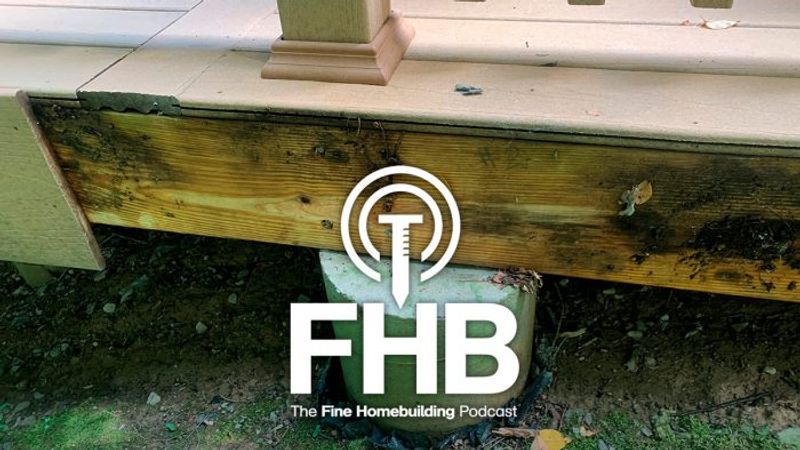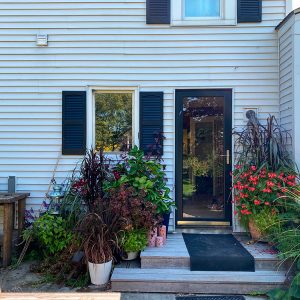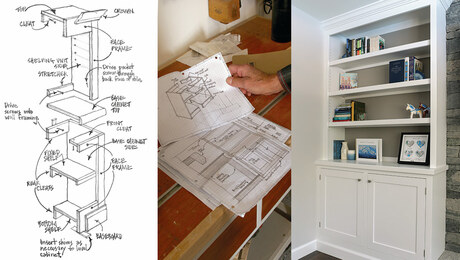Podcast 285: Waterproofing Curbless Showers, Adding Storage to Trusses, and Electrical Permits for DIY Projects
Rob, Kiley, and Patrick hear from listeners about sweating pipes and spray foam before taking questions about waterproofing a bathroom with a curbless shower, getting permits for DIY electrical work, and properly detailing decks.

Follow the Fine Homebuilding Podcast on your favorite app. Subscribe now and don’t miss an episode:
 |
 |
Help us make better episodes and enter for a chance to win an FHB Podcast T-shirt:
www.finehomebuilding.com/podcastsurvey
Doug talks about his switch from copper to PEX for DIY plumbing. Another Doug offers his take on spray-foam problems. Nils asks how to waterproof the plumbing penetrations in his wet bathroom. Shane asks about using the trusses in his shop for storage. Brian asks if not issuing electrical permits to DIYers is a good idea. Mark asks about debris-trapping deck details.
Editor Updates:
- Rob’s kitchen window renovation
- Kiley’s BS & Beer Show Book Club and the beauty of wood
- Jeff’s yardwork and fridge repair
- Patrick’s generator and Aerobarrier shoot with Ross MacPherson of New England Air Barrie
 |
 |
 |
 |
 |
 |
 |
 |
 |
 |
 |
 |
 |
 |
Listener Feedback 1:
Doug writes: Hi All, After hearing the dire warning in episode #279 about sweating copper I felt I had to write. In 1983 I was contemplating a total gut remodel of our second floor bathroom. I talked to my neighbor who was a licensed plumber and owned a small plumbing supply store about doing the job.
He convinced me that I could do it myself. The job included all new supply, waste and vent lines. When teaching me to sweat coper he said there were four important things. Clean the copper properly, use Oatey solder and Oatey paste, and don’t burn off the flux. I bought all the pipe and fittings from him and he came over regularly to inspect my work. We lived there for over 25 years with no problems.
Having said all that, when I built our new home I went with PEX except for the copper I needed to build the tub/shower manifolds. I much prefer PEX. One last bit of historical trivia. Before the fire proof safety fabric was developed it was common to just buy a roll of asbestos paper.
I also thought of The Great Escape with the question about new footings.
Stay Safe
Related Links:
Listener Feedback 2:
Doug writes: Loved the podcast as usual, and glad to see we’re focusing on air sealing again!
We’ve used a fair amount of spray foam and generally speaking I don’t see it “shrink away” from framing. We are still crawling around in attics we foamed a decade or more ago, and I usually keep an eye out for this kind of thing.
 We do see foam fail early—like the same week—when we mess up the application process.
We do see foam fail early—like the same week—when we mess up the application process.
In particular, before we knew better we would sometimes spray cold surfaces, or worse, cold surfaces we were trying to warm up with propane heaters inside unfinished houses. Spraying cold substrates, I’ve read, causes multiple issues with foam including poor adhesion, bad mixing and incomplete chemical reactions. Spraying cold sheathing two hours after you fired up a propane heater in the space adds another issue and is much worse. You can leave the explanation for that as a puzzler for next week if you want! [or call/email me.] Bottom line, winter spraying is tough and an electric heater or other method is needed.
Foam has sometimes failed quickly without us doing dumb things with cold surfaces. I assume the ratio of the two parts was off, or something about the chemicals went bad. We once had an entire wall of foam shrink so much it ripped into small pieces a couple of days after install.
As far as air sealing goes, spray foam usually does a pretty good job, but we often (nearly always) find an area that was missed, especially in complicated remodels. We use a thermal camera to QC foam the day after it’s sprayed and there are usually a lot of little misses and often a big one.
Overall my experience is foam not adhering is pretty unusual, and my guess is there’s a specific reason for most cases.
It’s still an expensive and risky material that I’m not super enthusiastic about, but can’t seem to find a great alternative for in some scenarios.
Related Links:
Question 1: How do you waterproof plumbing floor penetrations in a wet bathroom?
Nils Southern California writes, Hello podcast friends- long time listener since about podcast 50 or so…loving the current generation.
Here’s a question on the verge of several disciplines: design, tile, plumbing at least.
I (experienced DIY, property owner and manager) am redoing our personal master bath.
Curbless showers are all the rage these days and Schluters offerings make it look simple so far. I’ve done several standard bath remodels myself but never a curbless shower.
The room is 65” wide, 92” deep. Window on the far end on the 65” wall, skylight above. We would love a freestanding tub for looks, based on dimensions it would have to and go along a back wall, accessing it by stepping through the shower in front. I figure I can get easily get the minimum size for the shower pan doing it this way- >60” wide and more than 32” deep. Drainage should be a linear drain dividing the space.
Everything looks easy peasy until I start to consider how waterproofing a freestanding tub in a wet room would work. I gather that many tubs have some combination of caulking and mechanical anchors to hold them in place, but at a minimum the drain penetration has to be waterproofed. I don’t see guidelines anywhere.
Let’s say I get that sorted out, how are potential seepage leaks handled underneath the tub? I would prefer not to merely hope water never leaks under that joint. Is it appropriate to slope the floor under the tub to promote drainage?
Help or suggestions? I have to imagine there are good details for this setup since I see pictures all over Pinterest, Instagram etc.
This application is over our recently remodeled kitchen and I’m sure my wife would hate to have shower water dripping onto us while we are cooking.
Cheers from pleasant Southern California.
— — — — — — — —
From Doug Horgan Vice President, Best Practices
BOWA
We’ve used a combination of strategies to reduce the water load in these vulnerable areas, and then to do the best we can with the penetrations.
1) Keep tub out. C’mon people.
2) Set tub on small curb raised above shower floor area, or at least at high end of significant slope to drain. Unlike catalog photos showing curbless showers with like half an inch of total fall, we do our best to engineer significant (>1″) fall in curbless showers, otherwise a simple and common hair clog can cause a multi-thousand dollar flood restoration. These ones with a slot drain at the door, with the entire floor sloping up from there, is particularly crazy in my opinion.
3) Slope waterproofing around tub to keep water from running toward The tub’s drain & supply lines. (Tile can be set level at tub footprint).
4) Use wall-mounted faucets rather than floor-mounted versions.
5) At least put floor-mounted faucets as far from the shower area as you can–on the other side of the tub from the shower.
6) There’s a Kohler floor-mounted roughin that mounts below floor level–that one should not be used in splash area–super challenging to manage water. More “traditional” floor mounted faucets have connections above the tile, the rough connections can be sealed to the waterproofing layer with a reasonable expectation of success.
7) Use some combination of sheet & goop waterproofing to create small turned-up curb and/or seal directly to the pipes or rough-in fittings.
8) Deck-mount tubs are actually even harder to deal with, generally speaking. Undermount slightly better but keep the plumbing out of the deck (wall mount again) if at all possible.
Related links:
Question 2: Possible loft in pole barn or horrible crushing death?
Shane writes, Good morning FHB. I hope this email finds you all well. 🙂
I have a question (not air sealing) that I’m hoping you might be able to advise me on. My wife (She who must be obeyed) and I moved into our forever home 3.5 years ago, A log cabin on 5 acres, on the edge of the woods. I lucked out and there is a 30′ x 48′ pole barn on the property that is going to be my woodshop/ mechanic/ and eventual blacksmith shop. ?
I’m in the process of building a wood floor over a very thick bed of gravel (treated 2×6 sleepers on a 6 mil vapor barrier), but being the forward looking individual that I am, I was thinking about building a small-ish loft for storage but I’m concerned that the bottom chord (30′ span of 2×4’s, with a splicing plate just left of dead center) isn’t anywhere close to being sufficient. I was wondering if these rafters could be reinforced enough to hold some 3/4″ plywood, by adding two vertical supports, connecting to the top (2×6’s) and bottom chord and sistering 2×8’s across the center sections of the bottom chord? I’ll attach some pics to help explain what I’m talking about.
What do you think? I tend to over-engineer most anything I build, but I’m not sure that it is even worth trying.
 |
 |
 |
Related links:
Question 3: Does it discourage safe remodeling practices when towns prevent homeowners from getting permits?
Brian from Maine writes, Hello Podcast previously known as the roof venting podcast,
You answered my question a few weeks ago about drywall vs drop ceiling for my basement finishing and I wanted to say thank you for being the final push I needed to drywall the ceiling. I was leaning that way, but the electrician I’ve used for a sub panel install had the expected concerns. A new topic for discussion around electrical permitting that came up during the same project.
I live in Maine in a town that does not allow owners to pull their own electrical permits, and without going into boring details, I am fairly confident I can run the simple circuits needed for my basement to be up to code (probably would need a second bite admittedly). My question is around this decision from the town. While I would never even think of continuing to do beginning small wiring projects without a permit, this policy seems like a good way to push capable DIYers into just not bothering and not getting the benefit of the inspection to correct issues.
I’m curious if there are any inspectors out there who have a different perspective? Maybe have worked in communities with both policies and something I’m not thinking of came up. I’m sure they don’t like inspecting homeowner work (like all inspectors) but this seems like a bad incentive that has no real upside. Non capable owners will just continue using pros and DIYers will just avoid the permitting process all together.
As I said, I am willing to be convinced otherwise, but unless code enforcement made a show of knocking on the door of every person buying Romex from the box stores (and inspecting their amazon boxes), I just don’t see that as a real deterrent for small scale projects. Even worse, not allowing for inspection of the work needing it most seems like doubling down on a bad scenario.
Related links:
- Do You Need a Building Permit?
- One Full Year, Eight Building Permits
- Electrical Outlets by the Numbers
Question 4: What’s the best way to trim out the border of a deck?
Mark from the Hudson Valley of New York writes, Hey FHB crew, My name is Charles and I live in the great country of Canada in a small town about 1 hour north of Toronto. I am just getting into carpentry as a career. I work for a framing crew that does new residential construction and I am loving every minute of it.
My question concerns log homes. I have listened to quite a few podcasts over the past year (in light of a broken leg that kept me off work for 3 months) and I am curious to hear your thoughts on log homes as a building platform? What are things you like about them? What are factors that scare you? Pros vs cons and if you recommend them over a conventional stick framed house?
I look forward to hearing your thoughts and I thank the team that makes these podcasts possible. It has been a source of inspiration for me as I made the transition into the trade full time and bought our first house a year and a half ago.
 |
 |
 |
Related links:
- Adding Fascia on an Elevated Deck
- An Elegant Border for Your Deck
- TimberTech AZEK Deck Rim Joist Covers (see pg.14 of this install guide)
Help us make better episodes and enter for a chance to win an FHB Podcast T-shirt: www.finehomebuilding.com/podcastsurvey
If you have any questions you would like us to dig into for a future show, shoot an email our way: [email protected].
If we use your question we’ll send you a FHB Podcast sticker!
FHB Podcast T-shirts!
Represent your favorite podcast! Available in several styles and colors. Made from 100% cotton. Find the Podcast t-shirt and more cool products in the Fine Homebuilding Store.
This episode of the Fine Homebuilding podcast is brought to you by Benjamin Obdyke.
Benjamin Obdyke would like to thank the nuisances that builders and homeowners despise. A water-resistant-barrier and rainscreen are the ideal applications to eliminate the threat of moisture from things like rain, snow, and the neighbor’s sprinkler system. Take Slicker HP, a durable Water-Resistant-Barrier attached to the Slicker Rainscreen system. This all-in-one housewrap and rainscreen won’t just protect your wall assembly, but your time and wallet, as well. It’s not rocket science… It’s building science.
Visit benjaminobdyke.com for more.
Fine Homebuilding podcast listeners can now get 20% off anything in the Taunton store, including the Renovation, 5th Edition.
Use the discount code FHBPODCAST to take advantage of this special offer.
We hope you will take advantage of a great offer for our podcast listeners: A special 20% off the discounted rate to subscribe to the Fine Homebuilding print magazine. That link goes to finehomebuilding.com/podoffer.
The show is driven by our listeners, so please subscribe and rate us on iTunes or Google Play, and if you have any questions you would like us to dig into for a future show, shoot an email our way: [email protected]. Also, be sure to follow Fine Homebuilding on Instagram, and “like” us on Facebook. Note that you can watch the show above, or on YouTube at the Fine Homebuilding YouTube Channel.
The Fine Homebuilding Podcast embodies Fine Homebuilding magazine’s commitment to the preservation of craftsmanship and the advancement of home performance in residential construction. The show is an informal but vigorous conversation about the techniques and principles that allow listeners to master their design and building challenges.
Other related links
-
- All FHB podcast show notes: FineHomebuilding.com/podcast.
- #KeepCraftAlive T-shirts and hats support scholarships for building trades students. So order some gear at KeepCraftAlive.org.
- The direct link to the online store is here.




























View Comments
Zonebao Molecular Sieve Co.,Ltd is a manufacuturer specilizes in molecular sieve serial products in Chin Our precept is using our sincerity and perspiration to win your trust and cooperation. https://topsieve.com/